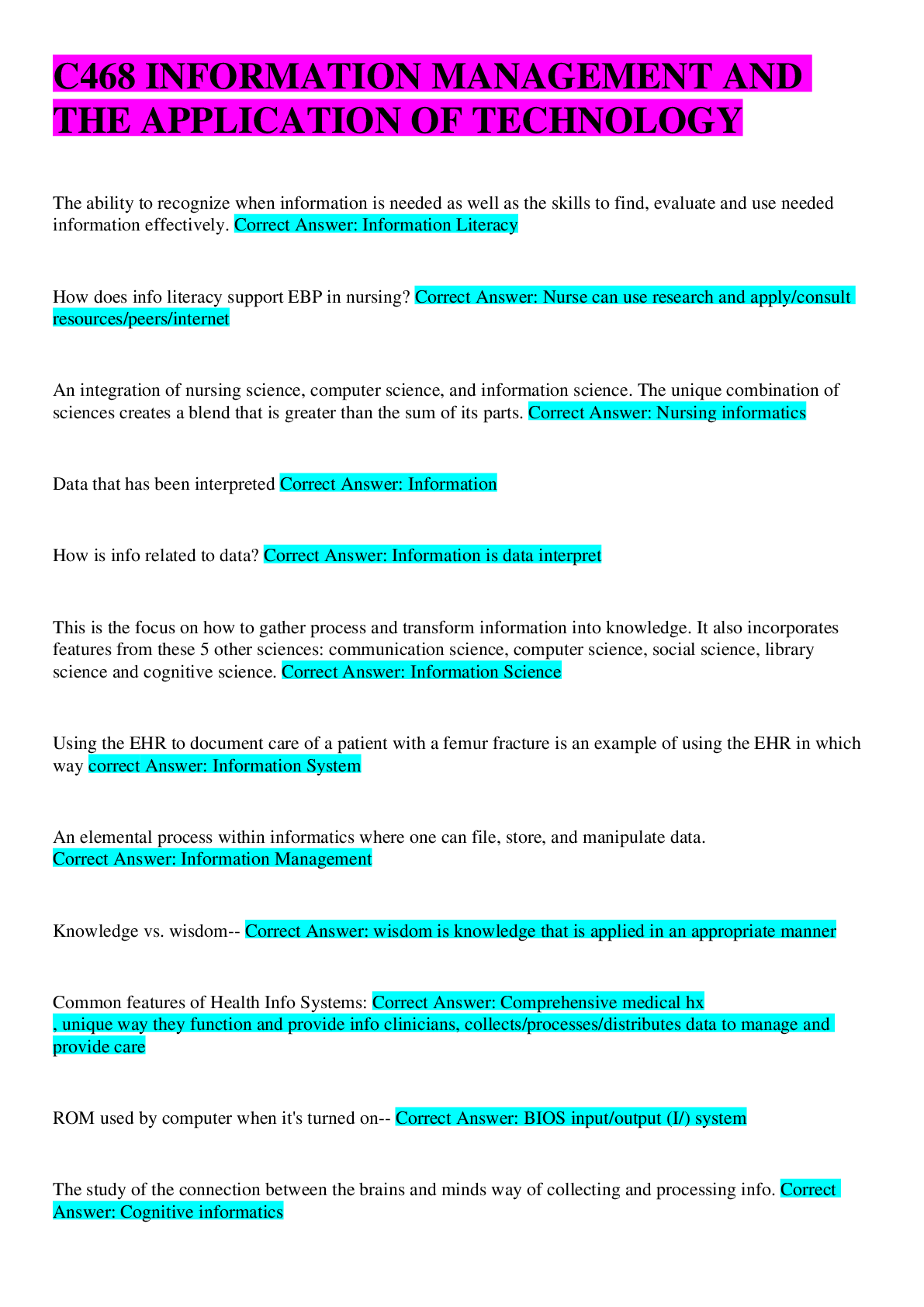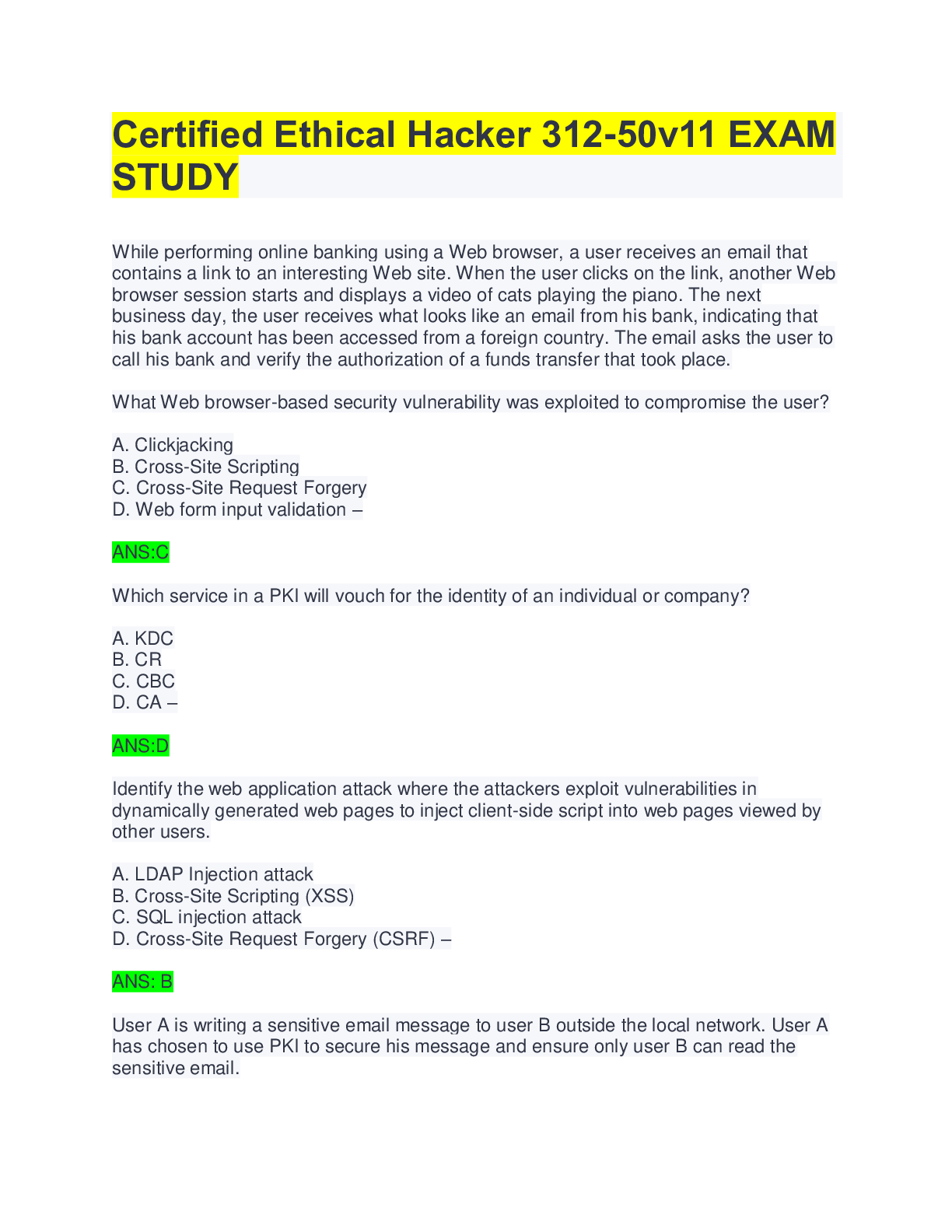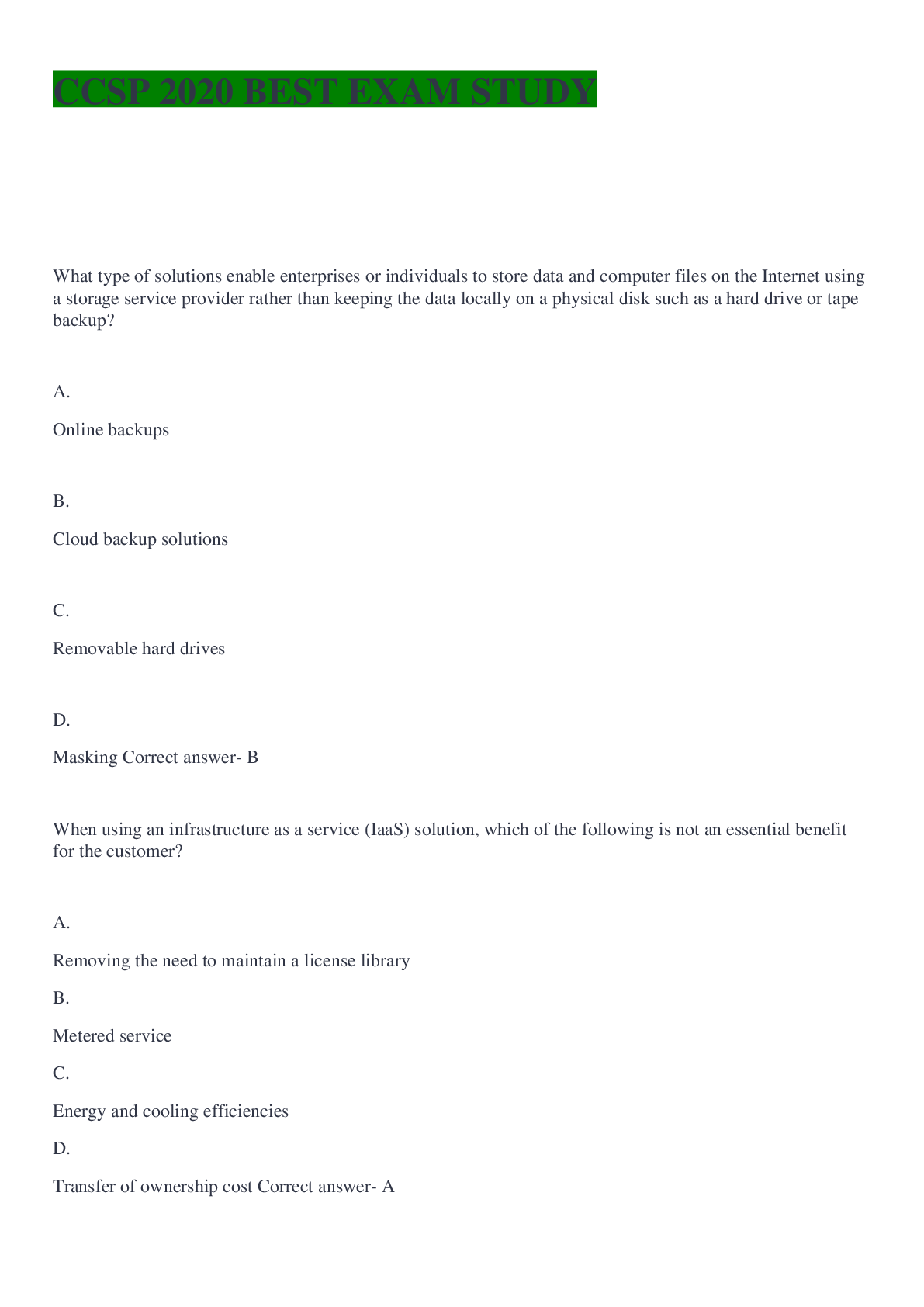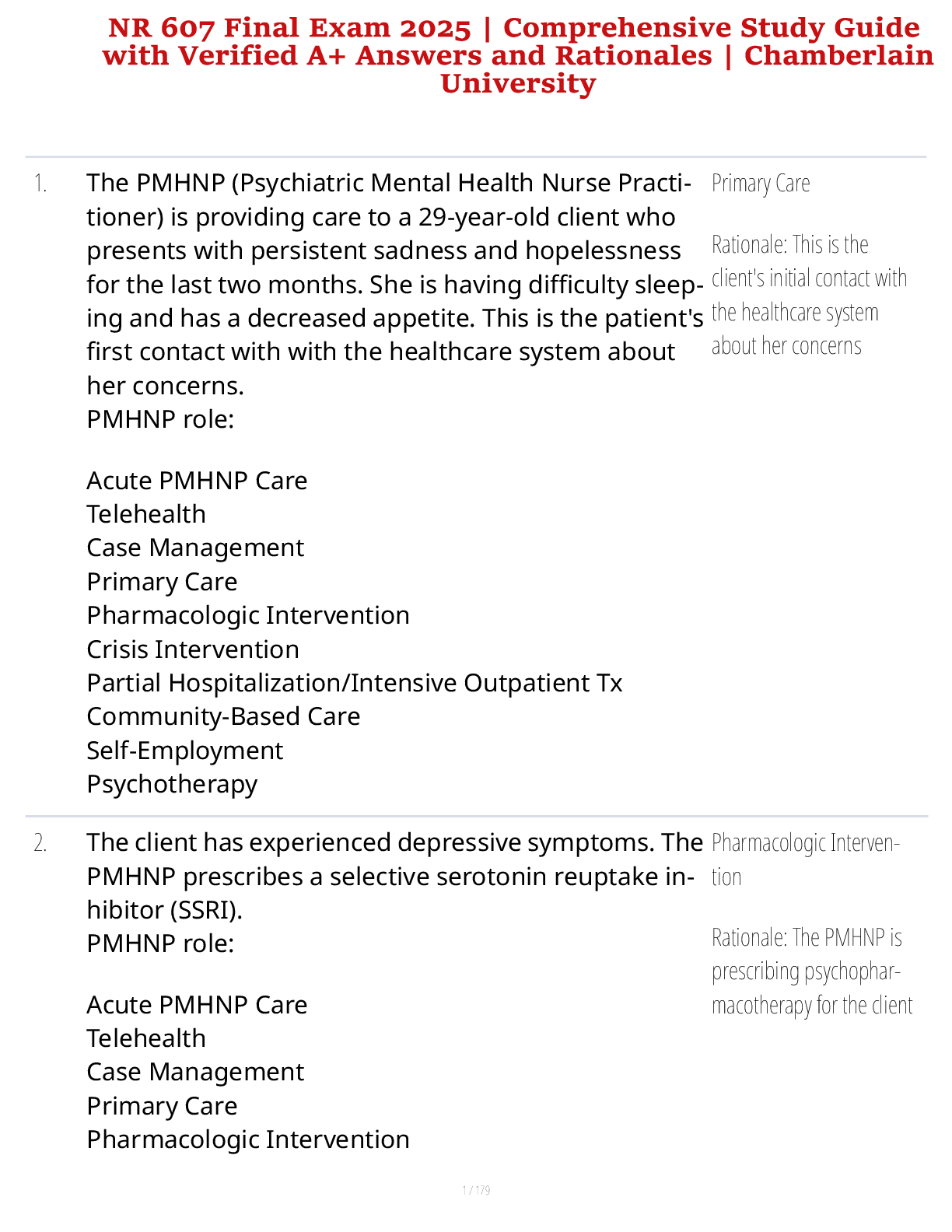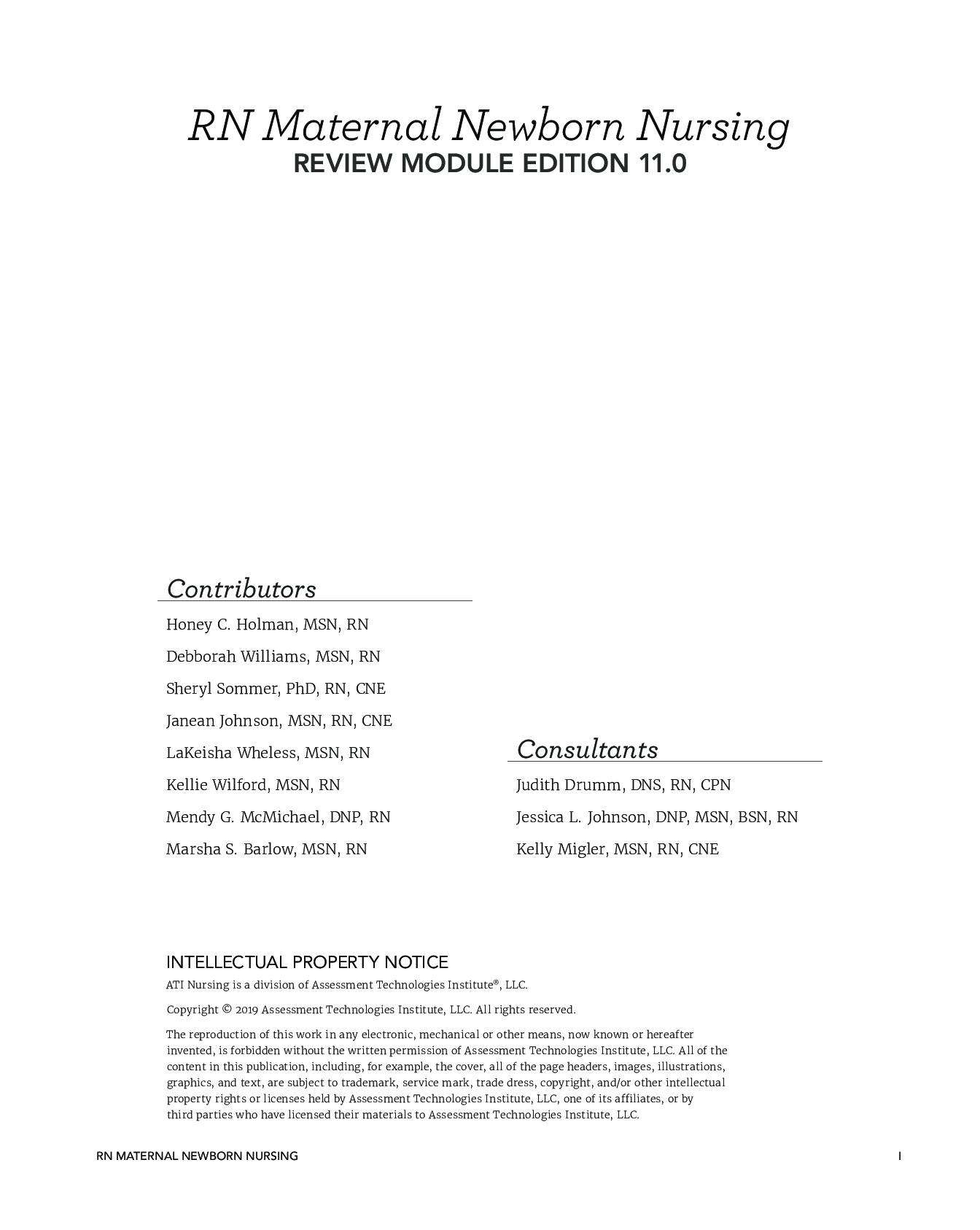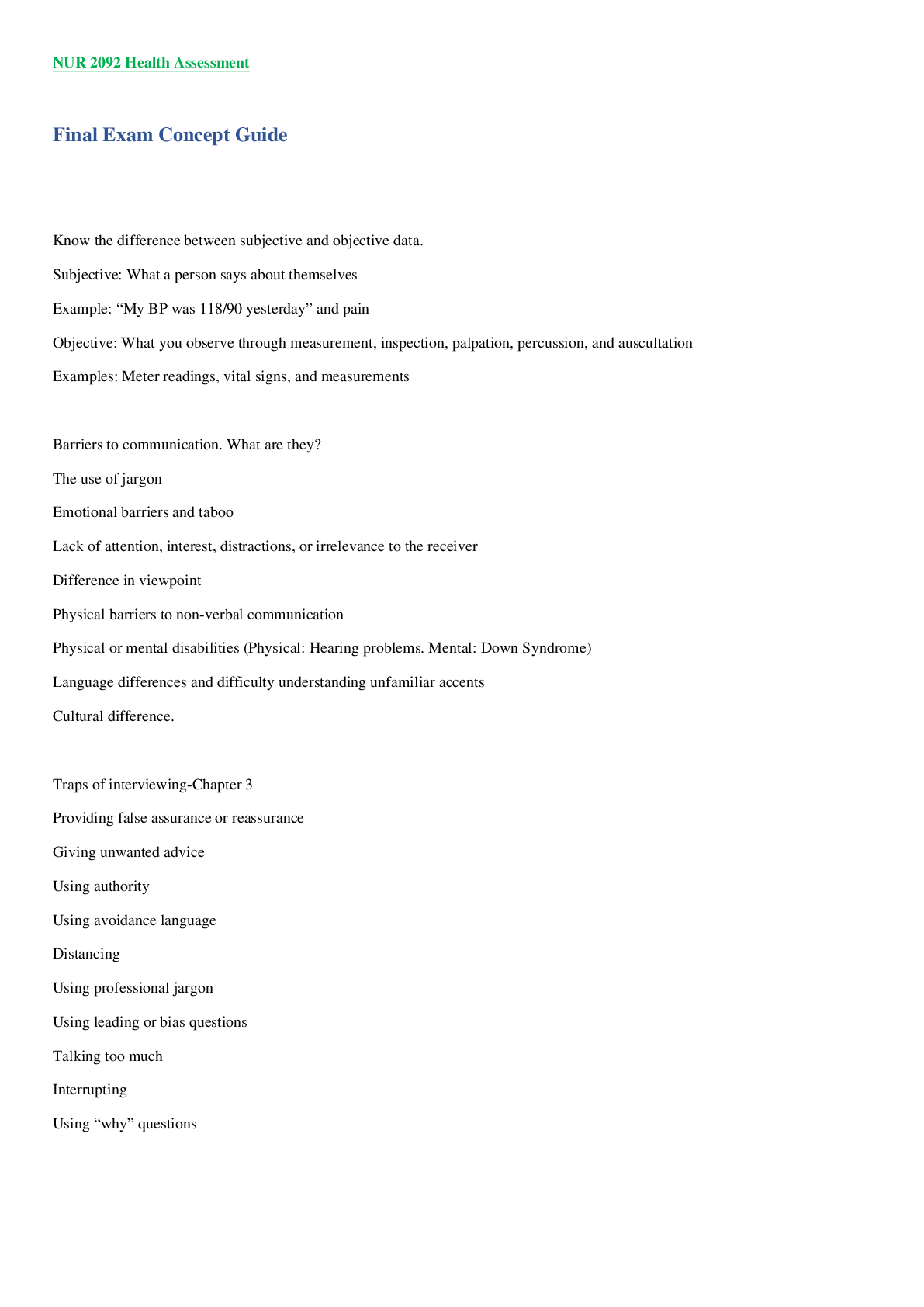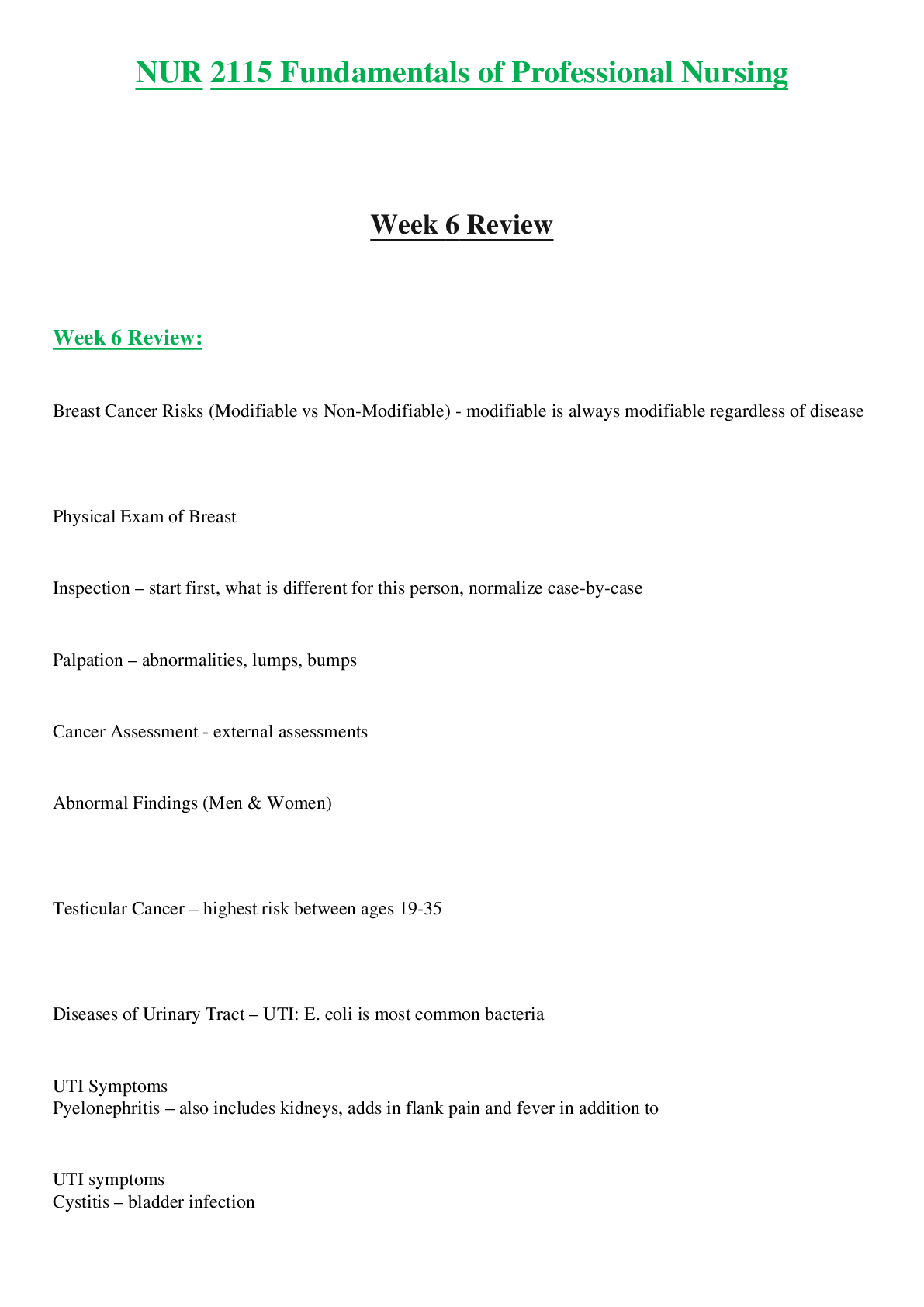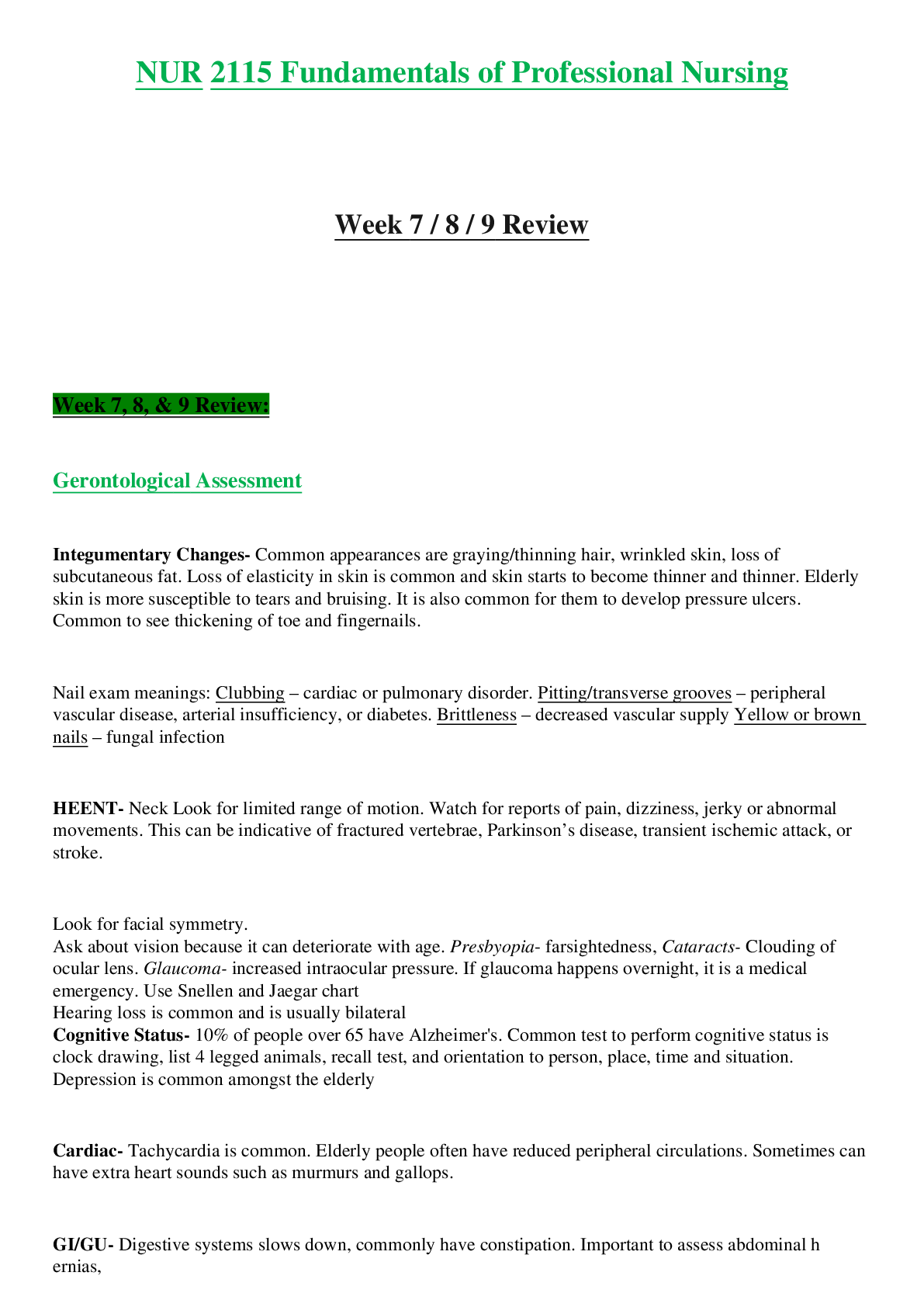Biology > STUDY GUIDE > Chapter 22: Neurologic System Test Bank Seidel’s Guide to Physical Examination-8th Edition-Jane W. (All)
Chapter 22: Neurologic System Test Bank Seidel’s Guide to Physical Examination-8th Edition-Jane W. Ball
Document Content and Description Below
Chapter 22: Neurologic System Test Bank Seidel’s Guide to Physical Examination-8th Edition-Jane W. Ball MULTIPLE CHOICE 1.The autonomic nervous system coordinates which of the following? a.High- ... level cognitive function b.Balance and affect c.Internal organs of the body d.Balance and equilibrium ANS:C The autonomic nervous system coordinates the internal environment of the body by the sympathetic and parasympathetic nervous systems. The other options are associated with the cerebral cortex; its function consists of determining intelligence, personality, and motor function. 2.The major function of the sympathetic nervous system is to: a.orchestrate the stress response. b.coordinate fine motor movement. c.determine proprioception. d.perceive stereognosis. ANS:A Stimulation of the sympathetic branch of the autonomic nervous system prepares the body for emergencies for fight or flight (stress response). The cerebellum plays a key role in the coordination of fine motor movements. Recognition of body parts and awareness of body position (proprioception) are dependent on the parietal lobe. Stereognosis is the ability to perceive the weight and form of solid objects by touch and is not under sympathetic control. 3.The parasympathetic nervous system maintains the day-to-day function of: a.digestion. b.response to stress. c.lymphatic supply to the brain. d.lymphatic drainage of the brain. ANS:A The parasympathetic division functions in a complementary and counterbalancing manner to conserve body resources and maintain day to day body functions, such as digestion and elimination. 4.Cerebrospinal fluid serves as a: a.nerve impulse transmitter. b.red blood cell conveyer. c.shock absorber. d.mediator of voluntary skeletal movement. ANS:C Cerebrospinal fluid circulates between an interconnecting system of ventricles in the brain and around the brain and spinal cord, serving as a shock absorber. 5.Diabetic peripheral neuropathy will likely produce: a.hyperactive ankle reflexes. b.diminished pain sensation. c.exaggerated vibratory sense. d.hypersensitive temperature perception. TEST BANK CHAPTER 22: NEUROLOGIC SYSTEM ANS:B Peripheral neuropathy is a disorder of the peripheral nervous system that results in motor and sensory loss in the distribution of one or more nerves, usually in the hands and feet. Patients may have sensations of numbness, tingling, burning, and cramping. In moderate to severe diabetic neuropathy, there is wasting of the foot muscles, absent ankle and knee reflexes, decreased or no vibratory sensation below the knees, and/or loss of pain or sharp touch sensation to the midcalf level. 6.The thalamus is the major integration center for the perception of: a.speech. b.olfaction. c.pain. d.thoughts. ANS:C The thalamus is the major integrating center for the perception of various sensations such as pain and temperature, serving as the relay center between the basal ganglia and cerebellum. The reception of speech and interpretation of speech are located in the Wernicke area. The olfactory sense is processed in the parietal lobe. The cerebrum holds memories, allows you to plan, and enables you to imagine and think. 7.The awareness of body position is known as: a.proprioception. b.graphesthesia. c.stereognosis. d.two-point discrimination. ANS:A Recognition of body parts and awareness of body position are known as proprioception. This is dependent on the parietal lobe. The other options are assessment techniques that test for sensory impairment. 8.Which area of the brain is responsible for perceiving sounds and determining their source? a.Frontal lobe b.Occipital lobe c.Parietal lobe d.Temporal lobe ANS:D The temporal lobe is responsible for the perception and interpretation of sounds and determination of their source. The frontal lobe contains the motor cortex associated with voluntary skeletal movement. The occipital lobe contains the primary vision center. The parietal lobe is primarily responsible for processing received sensory data. 9.Peripheral nerves that arise from the brain rather than the spinal cord are called ___________ nerves. a.sympathetic b.parasympathetic c.cranial d.autonomic ANS:C Cranial nerves are peripheral nerves that arise from the brain rather than the spinal cord. The other choices refer to the autonomic nervous system. 10.Which area of the brain maintains temperature control? a.Epithalamus b.Thalamus c.Abducens d.Hypothalamus ANS:D The hypothalamus is the major processing center of internal stimuli for the autonomic nervous system. It maintains temperature control, water metabolism, body fluid osmolarity, feeding behavior, and neuroendocrine activity. The epithalamus houses the pineal body and is responsible for sexual development and behavior. The thalamus conveys all sensory impulses, except olfaction, to and from the cerebrum before their distribution to appropriate associative sensory areas. The abducens is the sixth cranial nerve with motor function responsible for lateral eye movement. 11.If a patient cannot shrug his or her shoulders against resistance, which cranial nerve (CN) requires further evaluation? a.CN I, olfactory b.CN V, trigeminal c.CN IX, glossopharyngeal d.CN XI, spinal accessory ANS:D CN XI is responsible for the motor ability to shrug the shoulders. CN I is associated with smell reception and interpretation. CN V is associated with opening of the jaw, chewing, and sensation of the cornea, iris, conjunctiva, eyelids, forehead, nose, teeth, tongue, ear, and facial skin. CN IX is associated with swallowing function, sensation of the nasopharynx, gag reflex, taste, secretion of salivary glands, carotid reflex, and swallowing. 12.Motor maturation proceeds in an orderly progression from: a.peripheral to central. b.head to toe. c.lateral to medial. d.pedal to cephalic. ANS:B Motor maturation proceeds in a cephalocaudal direction. Motor control of the head and neck develops first, followed by the trunk and extremities. The other choices are incorrect because they relate the maturation sequence inappropriately, from outward to central. 13.Normal changes of the aging brain include: a.increased velocity of nerve conduction. b.diminished perception of touch. c.increased total number of neurons. d.diminished intelligence quotient. ANS:B Sensory perceptions of touch and pain are diminished by aging. The velocity of nerve impulse conduction declines, so responses to stimuli take longer. The number of cerebral neurons is thought to decrease by 1% a year, beginning at 50 years of age; however, the vast number of reserve cells inhibits the appearance of clinical signs. 14.The area of body surface innervated by a particular spinal nerve is called a: a.dermatome. b.nerve pathway. c.spinal accessory area. d.cutaneous zone. ANS:A The sensory and motor fibers of each spinal nerve supply and receive information to a segment of skin known as a dermatome. Nerve pathway and spinal accessory area refer to nerve routes. Cutaneous zone refers to a skin area that transmits fine mechanical information and normal exogenous thermal information at the same time. 15.A neurologic past medical history should include data about: a.allergies. b.circulatory problems. c.educational level. d.immunizations. ANS:B The neurologic past medical history should include data concerning neurovascular problems such as stroke, aneurysm, and brain surgery. The other answers are not pertinent medical information for the neurologic past medical history. 16.Which of the following is the technique most often used for evaluating the neurologic system? a.Auscultation b.Inspection c.Palpation d.Percussion ANS:B The evaluation tool of inspection is used most often. Inspection of gait and response to questions can provide data concerning neurologic system function. 17.When assessing superficial pain, touch, vibration, and position perceptions, you are testing: a.cerebellar function. b.emotional status. c.sensory function. d.tendon reflexes. ANS:C Superficial pain, touch, vibration, and position perceptions are sensory functions. 18.You are initially evaluating the equilibrium of Ms. Q. You ask her to stand, with her feet together and arms at her sides. She loses her balance. Ms. Q has a positive: a.Kernig sign. b.Homan sign. c.McMurray test. d.Romberg sign. ANS:D The Romberg test has the patient stand with the eyes closed, feet together, and arms at the sides. A slight swaying movement of the body is expected, but not to the extent of falling. Loss of balance results in a positive Romberg test. The Kernig sign indicates meningeal irritation, the Homan sign indicates venous thrombosis, and the McMurray test is a rotation test for demonstrating a torn meniscus. 19.The finger to nose test allows assessment of: a.coordination and fine motor function. b.point location. c.sensory function. d.stereognosis. ANS:A To perform the finger to nose test, the patient closes both eyes and touches his or her nose with the index finger, alternating hands while gradually increasing the speed. This tests coordination and fine motor skills. All the other choices test sensory function without motor function. 20.You are performing a two-point discrimination test as part of a well physical examination. The area with the ability to discern two points in the shortest distance is the: a.back. b.palms. c.fingertips. d.upper arms. ANS:C The fingertips can discern two points with a minimal distance of 2 to 8 mm, the back, 40 to 70 mm, the palms, 8 to 12 mm, and the upper arms, 75 mm. 21.As Mr. B enters the room, you observe that his gait is wide-based and he staggers from side to side while swaying his trunk. You would document Mr. B’s pattern as: a.dystonic ataxia. b.cerebellar ataxia. c.steppage gait. d.tabetic stamping. ANS:B A cerebellar gait (cerebellar ataxia) occurs when the patient’s feet are wide-based, with a staggering gait, lurching from side to side, often accompanied by swaying of the trunk. Dystonic ataxia is jerky dancing movements that appear nondirectional. Steppage gait is noted when the hip and knee are elevated excessively high to lift the plantar-flexed foot off the ground. The foot is brought down with a slap and the patient is unable to walk on the heels. Tabetic stamping occurs when the legs are positioned far apart, lifted high, and forcibly brought down with each step; in this case, the heel stamps on the ground. 22.Deep pressure tests are used mostly for patients who are experiencing: a.absent superficial pain sensation. b.gait and stepping disturbances. c.lordosis, osteoporosis, or arthritis. d.tonic neck or torso spasms. ANS:A Deep pressure sensation is tested by squeezing the trapezius, calf, or biceps muscle, thus causing discomfort. When superficial pain sensation is not intact, further assessments of temperature and deep pressure sensation are performed. 23.Vibratory sensory testing should be routinely done for the patient with: a.Parkinson disease. b.diabetes. c.cerebral palsy. d.Guillain-Barré syndrome. ANS:B Diabetic neuropathy must be routinely assessed in all diabetic patients. In moderate to severe cases, decreased or absent vibratory sensation occurs below the knees, which should be assessed with a tuning fork. The other choices do not result in sensation deficits. 24.To assess a cremasteric reflex, the nurse strokes the: a.sole of the foot and observes whether the toes fan down and out. b.abdomen and observes whether the umbilicus moves away from the stimulus. c.inner thigh and observes whether the testicle and scrotum rise on the stroked side. d.palm and observes whether the fingers attempt to grasp. ANS:C Stroking the inner thigh of a male patient (proximal to distal) will elicit the cremasteric reflex. The testicle and scrotum rise on the stroked side. Stroking the sole of the foot elicits a Babinski sign. Stroking the abdomen elicits an abdominal reflex. Stroking the palm elicits a palmar grasp. 25.When you ask a patient to close her or his eyes and identify an object placed in the hand, you are evaluating: a.stereognosis. b.graphesthesia. c.vibratory sensation. d.extinction phenomenon. ANS:A. Stereognosis is the ability to recognize an object through touch and manipulation. Tactile agnosia, an inability to recognize objects by touch, suggests a parietal lobe lesion. Graphesthesia tests the patient’s ability to identify the figure being drawn on the palm. The vibratory sense uses a tuning fork placed on a bony prominence, and the extinction phenomenon tests sensation by simultaneously touching bilateral sides of the body with a sterile needle. 26.The ability to recognize a number traced on the skin is called: a.stereognosis. b.graphesthesia. c.an extinction phenomenon. d.two-point discrimination. ANS:B The ability to recognize a number traced on the skin is called graphesthesia. Stereognosis is the ability to recognize an object through touch and manipulation. The extinction phenomenon test and twopoint discrimination assess a person’s ability to discern the number of pinpoints and their location. 27.Which one of the following conditions is consistent with Brown-Séquard syndrome? a.Central sensory loss that is generalized b.Motor paralysis on the lesion side of the body c.Multiple peripheral neuropathy of the joints d.Spinal root paralysis below the umbilicus ANS:B Parietal spinal sensory syndrome (Brown-Séquard syndrome) is noted when pain and temperature sensation occur one to two dermatomes below the lesion on the opposite side of the body from the lesion. Proprioceptive loss and motor paralysis occur on the lesion side of the body. 28.To assess spinal levels L2, L3, and L4, which deep tendon reflex should be tested? a.Triceps b.Patellar c.Biceps d.Achilles ANS:B To assess spinal levels L2-L4, the patellar reflex should be tested. The patellar tendon is the only deep tendon that assesses the lumbar spinal level. The triceps and biceps tendon are tested to assess the cervical spine, whereas the Achilles tendon is tested to assess the sacral spine. 29.When using a monofilament to assess sensory function, the nurse: a.uses two simultaneous monofilaments on similar bilateral points and then compares results. b.applies both a monofilament and a pin on similar bilateral points and then compares results. c.applies pressure to the monofilament until the filament bends. d.strokes the monofilament along the skin from proximal to distal areas. ANS: C The monofilament is placed on several smooth spots of the patient’s plantar foot for seconds. Adequate pressure applied by the monofilament is measured by the bend of the monofilament. 30.Visible or palpable extension of the elbow is caused by reflex contraction of which muscle? a.Achilles b.Biceps c.Patellar d.Triceps ANS: D The triceps tendon, when directly hit with the reflex hammer just above the elbow, will cause contraction of the triceps muscle and extension of the elbow. 31.It is especially important to test for ankle clonus if: a.deep tendon reflexes are hyperactive. b.deep tendon reflexes are hypoactive. c.the Romberg sign is positive. d.the patient has peripheral neuropathy. ANS: A Test the ankle clonus when reflexes are hyperactive. Support the patient’s knee in a flexed position and briskly dorsiflex the foot with your other hand. If clonus is present, there is recurrent ankle plantar flexion movement as long as the examiner retains the foot in dorsiflexion. Sustained clonus signifies the hypertonia of an upper motor neuron lesion. 32.Which sign is associated with meningitis and intracranial hemorrhage? a.Babinski sign b.Asymmetric tonic neck reflex c.Doll’s eye movement d.Nuchal rigidity ANS: D A stiff neck or nuchal rigidity is a sign associated with meningitis and intracranial hemorrhage. Test this by lifting the head of the patient to touch the chin while the patient lies in a supine position. Pain and resistance to neck motion are associated with nuchal rigidity. 33.When assessing a 17-year-old for nuchal rigidity, you gently raise his head off the examination table. He involuntarily flexes his hips and knees. To confirm your suspicions associated with this positive test, you would also perform a test for the __________ sign. a.Kernig b.Babinski c.obturator d.Brudzinski ANS: A The first action elicited the Brudzinski sign. This sign is an indicator of meningeal irritation. To confirm meningeal irritation, you would test for the Kerning sign, also a meningeal sign. 34.On a scale of 1+ to 4+, which deep tendon reflex score is appropriate for a finding of clonus in a patient? a.1+ b.2+ c.3+ d.4+ ANS: D 1+ indicates a sluggish or diminished reflex. 2+ indicates an active or expected response. 3+ indicates more brisk than expected, slightly hyperactive. 4+ indicates brisk, hyperactive, with intermittent or transient clonus. 35.Cranial nerve XII may be assessed in an infant by: a.watching the infant’s facial expressions when crying. b.observing the infant suck and swallow. c.clapping hands and watching the infant blink. d.observing the infant’s rooting reflex. ANS: B Cranial nerve (CN) XII may be assessed in an infant by observing the infant suck and swallow, by pinching the nose, and then observing for the mouth to open and the tip of the tongue to rise in a midline position. Watching the infant’s facial expressions when crying assesses CN VII. Clapping hands and watching the infant blink tests CN VIII. Observing the rooting reflex assesses CN V. 36.You are most concerned for the infant who has a: a.weak palmar grasp at 3 months. b.strong stepping reflex at 2 months. c.weak plantar reflex at 9 months. d.strong tonic neck at 6 months. ANS: D The tonic neck reflex must disappear before the infant can roll over or bring his or her hands to their face; it should disappear by 6 months. The other choices are within expected ranges. 37.At what age should the infant begin to transfer objects from hand to hand? a.2 months b.4 months c.7 months d.10 months ANS: C Transferring objects hand to hand begins at 7 months. Purposeful release of objects is noted as a normal finding by 10 months. Purposeful movements, such as reaching and grasping for objects, begin at about 2 months of age. The progress of taking objects with one hand begins at 6 months. There should be no tremors or constant overshooting of movements. 38.An acute polyneuropathy that commonly follows a nonspecific infection occurring 10 to 14 days earlier and that primarily affects the motor and autonomic peripheral nerves in an ascending pattern is: a.cerebral palsy. b.HIV encephalopathy. c.Guillain-Barré syndrome. d.Rett syndrome. ANS: C Guillain-Barré syndrome—acute idiopathic polyneuritis—is an acute polyradiculoneuropathy that commonly follows a nonspecific infection that occurred 10 to 14 days earlier. It is characterized by ascending symmetric weakness with sensation preserved. An increase in severity occurs over days or weeks. A decrease in or absent strength and sensory loss may result, along with motor paralysis and respiratory muscle failure. 39.Which of the following is a concern, rather than an expected finding, in older adults? a.Reduced ability to differentiate colors b.Bilateral pill-rolling of the fingers c.Absent plantar reflex d.Reduction in upward gaze ANS: B Bilateral pill-rolling is indicative of Parkinson disease; the other choices are expected findings with aging. 40.Which of the following conditions is potentially life-threatening if not treated expeditiously with antibiotics? a.HIV encephalopathy b.Dementia c.Parkinson disease d.Bacterial meningitis ANS: D Meningitis is an inflammatory process in the meninges. Bacterial meningitis is a life-threatening illness if not rapidly treated with appropriate antibiotics. All the other diseases are neurologic disorders not treatable by antibiotics. 41.Ipsilateral Horner syndrome indicates a cerebrovascular accident (CVA) occurring in the: a.anterior portion of the pons. b.internal or middle cerebral artery. c.posterior inferior cerebellar artery. d.vertebral or basilar arteries. ANS: C The posterior inferior cerebellar artery supplies the lateral and posterior portion of the medulla. A CVA involving this artery can produce a neurologic sign of ipsilateral Horner syndrome in the eye. 42.The immune system attacks the synaptic junction between the nerve and muscle fibers, blocking acetylcholine receptor sites in: a.myasthenia gravis. b.encephalitis. c.multiple sclerosis. d.cerebral palsy. ANS: A Myasthenia gravis is a chronic autoimmune neuromuscular disease involving the lower motor neurons and muscle fibers. The immune system of infected individuals produces antibodies that destroy acetylcholine receptor sites at the neuromuscular junction. This blocks the nerve impulse from reaching the muscle and produces muscle fatigue. Encephalitis is acute inflammation of the brain and spinal cord involving the meninges. It is often caused by a virus, such as the herpes simplex virus. Multiple sclerosis is a progressive autoimmune disorder characterized by a combination of inflammation and degeneration of the myelin in the brain’s white matter, leading to obstructed transmission of nerve impulses and decreased brain mass. Cerebral palsy is a permanent disorder of movement and posture development associated with nonprogressive (static) disturbances that occurred in the developing fetal or infant brain. 43.Persons with Parkinson disease have an altered gait characterized by: a.short shuffling steps. b.the trunk in a backward position. c.exaggerated swinging of the arms. d.lifting the legs in a high-stepping fashion. ANS: A The altered gait of Parkinson disease has short shuffling steps, the posture is stooped forward, and the arms have limited swing. COMPLETION 1.You are assessing the deep tendon reflexes of a 28-year-old man. Your examination reveals that the patient’s reflexes are normal. You would document this finding as _____. ANS: 2+ Deep tendon reflexes are scored as follows: 0: No response 1+: Sluggish or diminished 2+: Active or expected response 3+: More brisk than expected, slightly hyperactive 4+: Brisk, hyperactive, with intermittent or transient clonus 2.The motor cortex of the brain is in the _______________. ANS: frontal lobe The frontal lobe contains the motor cortex associated with voluntary skeletal movement and fine repetitive motor movements, as well as the control of eye movements. 3.The major portion of brain growth and myelinization occurs between ____ and ____ year(s) old. ANS: birth; 1 The major portion of brain growth, along with myelinization of the brain and nervous system, occurs in the first year of life. MULTIPLE RESPONSE 1.The tests for cortical sensory function include which of the following? (Select all that apply.) a.Two-point discrimination b.Extinction phenomenon c.Superficial pain d.Stereognosis e.Touch [Show More]
Last updated: 3 years ago
Preview 1 out of 10 pages

Buy this document to get the full access instantly
Instant Download Access after purchase
Buy NowInstant download
We Accept:

Reviews( 0 )
$13.00
Can't find what you want? Try our AI powered Search
Document information
Connected school, study & course
About the document
Uploaded On
May 12, 2022
Number of pages
10
Written in
All
Additional information
This document has been written for:
Uploaded
May 12, 2022
Downloads
0
Views
153









